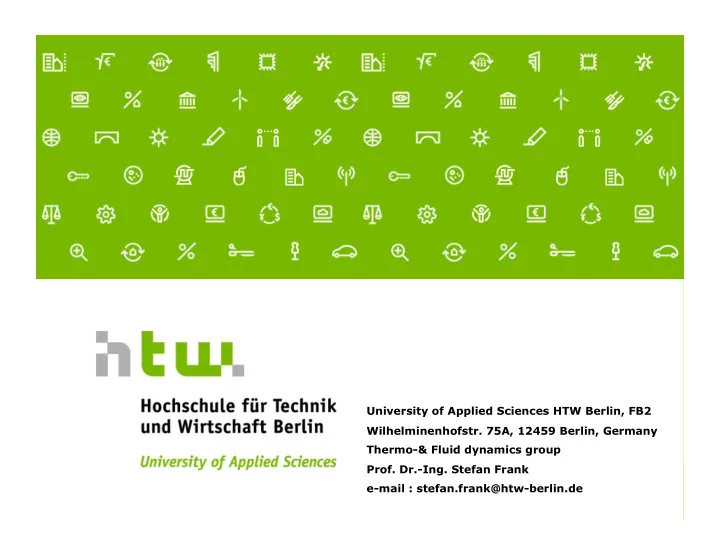

University of Applied Sciences HTW Berlin, FB2 Wilhelminenhofstr. 75A, 12459 Berlin, Germany Thermo-& Fluid dynamics group Prof. Dr.-Ing. Stefan Frank e-mail : stefan.frank@htw-berlin.de
Numerical Investigations on the Performance Characteristic of Radial Fans with Forward Curved Blades by means of CFD Manoochehr Darvish , Stefan Frank STAR European Conference 2011 March 22-23
Agenda Sirocco fan Introduction ◊ Applications ◊ Advantages/Disadvantages ◊ Characteristic curves Model parameters / Modeling physics CFD Simulations outline Rotation modeling Overview of the generated mesh configurations Results ◊ Characteristic curves: CFD vs. Experiment ◊ Simulation time ◊ Steady vs. Unsteady simulations Conclusions 3
Commonly used blade shapes in Radial fans (with their maximum attainable efficiencies) Key factors for fan type selection: ◊ Pressure ◊ Flow rate Forward curved Radial blades Radial-Tip blades ◊ Efficiency (60%) blades (65%) (70%) ◊ Noise generation ◊ Space constraints ◊ Drive configuration ◊ Cost ◊ ... Backward curved Backward inclined Backward inclined blades (85%) blades (78%) Airfoil blades (92%) 4
Sirocco fan specifications ◊ Large blade angles ◊ Small size relative to other fan types ◊ Operation at low speeds low level of noise Flow separation between the blades Low efficiency Scroll housing is required Applications: − Automotive industry − HVAC applications 5
Sirocco Fan Performance Curve Best Efficiency Point (BEP) Region of Instability Throttle Range Overload Range 6
Model Parameters ◊ Fan wheel outer diameter (D2) :200 mm ◊ Inner/Outer diameter (D1/D2) : 0.8 ◊ Number of blades : 38 ◊ Rotor width : 82 mm ◊ Scroll housing width: 87 mm ◊ Volute opening angle ( α ) :7° Modeling Physics Ideal gas Segregated flow Mass Inlet / Pressure outlet Rotational speed:1000 rpm Steady-State Moving Reference Frame (MRF) Rotor Positions: 0°,3°,6° 7
CFD Simulations outline Realizable k- ε Turbulence SST k- ω models Spalart-Allmaras Steady-state (Moving Reference Frame ) Polyhedral CFD Mesh Trimmer Simulations Configuration Polyhedral-Trimmer Structured grid SST k- ω Unsteady (Rigid Body Polyhedral Motion ) 8
Rotation of computational domains Rigid Body Motion (RBM) : Implicit unsteady Position of the cell vertices : Moving Instantaneous local flow behavior Time accurate solution Time consuming Powerful computer is needed 9
Rotation of computational domains Moving Reference Frame (MRF) : Frozen Rotor (in some literatures) Steady-state Position of the cell vertices: Fixed Constant grid flux generation conservation equations Approximate analysis of Motion (Time- averaged solution) Time efficient 10
Mesh configurations Polyhedral Trimmer Polyhedral- Structured Trimmer Mesh generator Star-CCM+ ANSYS ICEM Number of Cells Total 4.2 6.1 4.0 3.7 (in millions) Rotor 2.6 4.8 2.7 2.4 Stator 1.6 1.3 1.3 1.3 Interface Mesh Conformal Non-conformal Non-conformal Non-conformal Mesh generation time 2-4 hours 5-7 days Conformal Interface Non-Conformal Interface 11
Mesh configurations comparison 12
Mesh configurations comparison Workstation : CPU : Intel Core i7 (2.8 GHz) RAM : 8 GB 13
Turbulence models comparison 14
Turbulence models comparison Workstation : CPU : Intel Core i7 (2.8 GHz) RAM : 8 GB 15
Flow separation in the Nozzle at lower flow rates Non-uniform inlet flow: » Dominant flow field generated by Rotor » Flow attachment to one side & separation from the other side 16
Steady vs. unsteady simulation at 675 m ³ /h (Overload range) Steady Unsteady (MRF) (RBM) Static Pressure Torque Efficiency in Pa in Nm in % Exp. 115.8 0.500 41.5 MRF 112.6 0.460 43.9 RBM 114.5 0.470 43.7 17
Steady vs. unsteady simulation at 145 m ³ /h (Throttle range) Steady Unsteady (MRF) (RBM) Static Pressure Torque Efficiency in Pa in Nm in % Exp. 115 0.100 44 MRF 126 0.101 48 RBM 118 0.099 46 18
Conclusions Unstructured mesh configurations can be used effectively for simulating sirocco fans. The best results are achieved by using polyhedral cells. The best balance between the simulation time and accuracy is achieved by using Polyhedral cells as well. Trimmer (as a single mesher) is not suitable for sirocco fan simulation. SST k- ω turbulence model is the most suitable model for simulating sirocco fans. At intermediate and higher flow rates, steady-state MRF approach provides the same level of accuracy as unsteady RBM approach. At lower flow rates, flow becomes highly unsteady, and the flow condition is not suited to steady-state MRF approach. 19
Thank you for your attention!
Recommend
More recommend